
Nearly two years ago, shortly after we started this adventure, one of our first destinations was Gettysburg, PA, and we had decided to return for another visit this year. Besides being a beautiful area, it’s a fascinating place full of history, more than can be absorbed in just a couple of hours or days. Our stay last time was four days, but generally the day of arrival is pretty much wasted unless you can check-in early and the drive hasn’t been too far. This time we planned to stay a week, and the campground we

chose this year is only about a mile from Gettysburg National Military Park. Appropriately named Gettysburg Battlefield Resort, it is large and quite nice (though they do need to fix some of those pot holes in the roads). Beginning in May each weekend has its own theme, and this one was Wild West Weekend. We didn’t participate in any of the activities (most seemed geared towards kids), but did venture up to the pavilion Sat. night to check out the entertainment for a short time. As you can see by the picture, there were quite a few line dancers.
We had learned from the National Park Service website that there would be two events on the battlefield the weekend we’d be in town. Normally I would refer to these as re-enactments, but as we have learned in our travels, that term is generally used only for actual battle re-enactments and those cannot be performed on federal lands. Instead they are referred to as “Living History” presentations, and the various units attempt to accurately portray tactical demonstrations, military drills, and camp life. These units consist of men and women who have a deep affection for preserving history and paying tribute to the gallant men who served in the Civil War, an

d they are generally passionately dedicated to a specific side.
The first one we encountered on Sat. was the 6th New Hampshire Union Infantry (
http://www.6nhv.org/) who were camped in the park at Spangler’s Spring. There was to be a musket firing demonstration at 10am, so we arrived early to walk around the camp and visit with the “soldiers”. It’s always interest

ing and enlightening to talk to these folks. All have military ranks within their units, and Second Lt. Harry Bedford came up to welcome us and let us know about the upcoming demonstration. Wives and even children sometimes accompany the soldiers and are actually part of the units, dressing in period dress as well. All wear and use authentic reproductions of the clothing, equipment, and belongings of the time. Many are colle

ctors of Civil War memorabilia and experts on the period, ready to discuss, explain, and enlighten.
It was time for the men to fall in for the demonstration and march across the street to the open field. The park ranger welcomed us and introduced Capt. Walter Dewey who proceeded to explain the inner workings of the infantry. They are not allowe
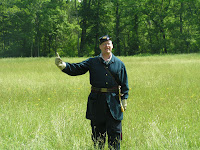
d to use live ammunition but do use black gun powder with blanks so the noise when they fire is loud! After three more firing demonstrations, they charged towards us scaring one little boy to tears. He was fine…it was just sudden and a little scary.
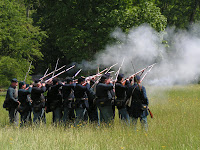
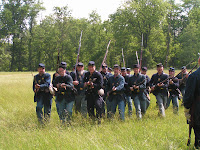
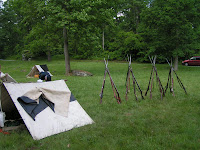
After returning to their camp, they were available to chat and answer questions. While we were standing there, a couple of the guys began re-stacking some of the muskets. One of the guys thrust two of them at Russ and said “Here, hold these” while they proceeded to get the other two set in formation. When
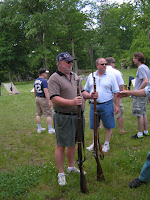
they were done, we asked a couple questions about how soldiers knew which rifle was theirs (they are arranged by height as is the regimental line), and spent the next 20 min. or so chatting with Private Peter Matthews. He showed us the inside of his cartridge pouch/box that holds the black gun powder explaining its usage, and then explained the many differences in uniforms worn by the Union sol

diers. The pants are not always the traditional blue you generally think of, and underneath their blue coats they might wear just about anything. In Peter’s case he said the plaid shirt he was wearing might have been one the soldier would have taken off a farmer’s clothesline when his white issued shirt was damaged. The green vest or waistcoat might have been something he admired in a store
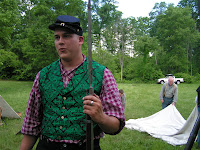
or someone from home sent him. Everything the re-enactors wear is authentic from the time period and would be what a soldier of the time would have worn. He showed us his pup tent where he had slept the night before and even offered to share a bite of his hardtack that he nibbles on throughout the day. Uh, thanks, but no thanks. It’s basically just a simple square biscuit made from flour, water, and salt that is h

ard as a rock. It’s what the soldiers were able to make in the camp quickly and easily and it would last seemingly forever. Peter is not only involved with Civil War re-enactments and living histories, but also World War II and the American Revolution. One thing he told us that surprised us is that kids attending the middle school where he did are not being taught any history. It is simply not a subject at that school any longer, and we all agreed it was definitely a shame. History does have a tendency to repeat itself.
We decided we had tied up enough of Peter’s time and bid him well as we proceeded to leave. We had originally planned to make it to the 11am presentation on the other side of the park, but on our way to the car began talking to another gentleman whose name, rank, and picture I did not get unfortunately. He collects a lot of Civil War memorabilia and was full of information. We spent about another 20 min. with him and missed the 11am demonstration. But that was okay because there was another one at 1pm.
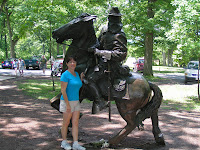
This next living history demonstration was the 4th Maryland Confederate Light Artillery (
http://www.4thmarylandlightartillery.com/military.html) who were camped in the park at Pitzer Woods. Located at this site stands the monument to Gen. James Longstreet who served under Gen. Robert E. Lee. Not far beyond this monu
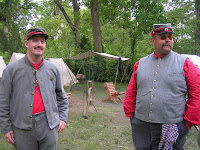
ment was the camp where we were greeted by Private Shawn Saez. Their camp had an entirely different setup and he explained that generally an infantry unit is constantly on the move, carrying everything on their backs, and set up wherever they plop for the night. Artillery units, however, are pretty much set in one location for a bit and nearly all their belongings are carried on the wagons pulling the cannons. Shortly Gunner Robert Candler joined us, and both men spent quite a bit of time describing things from the Confederate camp side. This unit is a family-oriented group with many family members involved, and a couple
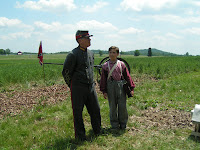
of the women are even in uniform as soldiers manning the Parrot Cannon.
Before long it was time for the demonstration and we walked across the street to the open field. As it so happens the same park ranger welcomed us and introduced Capt. Jean Buchen who proceeded to explain the inner workings of the artillery unit as the soldiers prepared for the demonstration. One of the

boys passed around one of the shells so we could feel just how heavy it was, and once again they would be firing blanks and we were advised to cover our ears. Everyone has their place and assignment in an artillery unit and soon all were prepared and ready. Glad they told us to cover our ears!

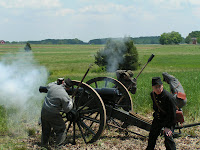
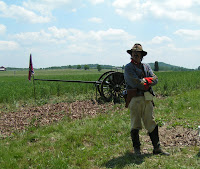
Afterwards they invited everyone to ask questions and to get a closer look at the cannon. During the entire demonstration there was a very distinguished looking gentleman in a slightly different uniform standing off to the side. At the end as he passed by, I asked him who he was and his role. As it turns out he was the Lt. Col. and is in charge of making sure everything runs smoothly and correctly. I chatted with him for quite a bit while Russ was talking with Shawn.
We’ll discuss the rest of our week here and the Visitor’s Center in the next blog entry.

No comments:
Post a Comment